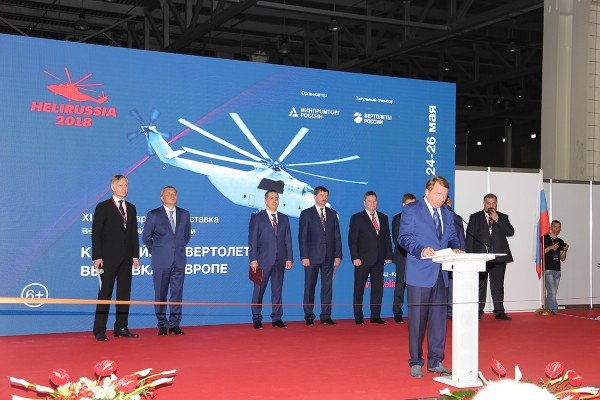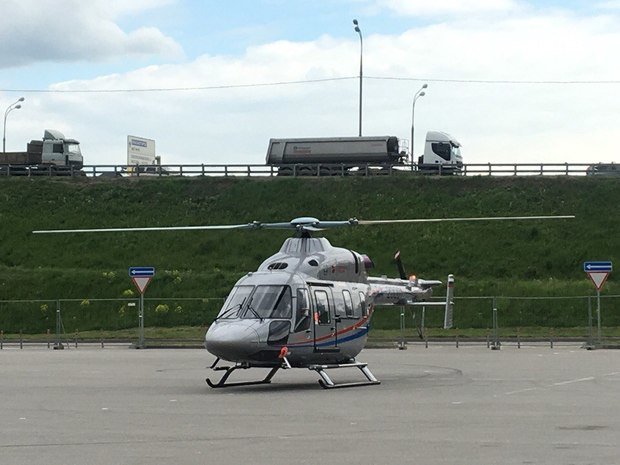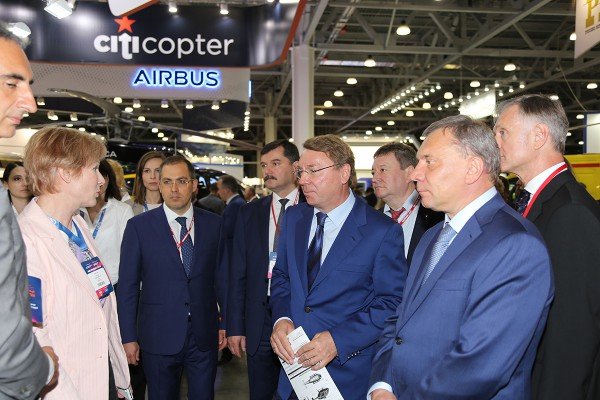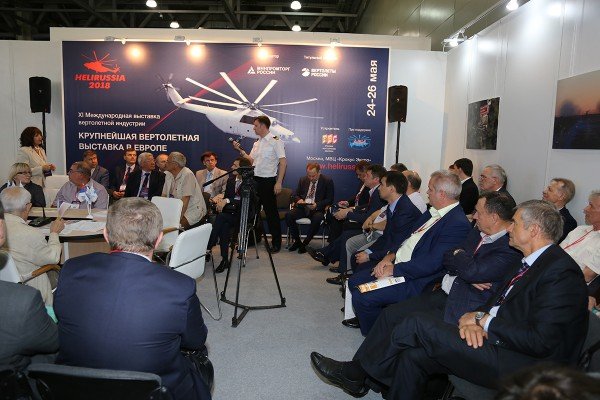Kazan Ansat on the bench: Kazan Helicopters aims at Chinese market, but 'ambush' waiting it here
Kazan Ansat helicopter will go on demonstration tour around Southeast Asia
''HeliRussia — no problem!'' repeated cheerful foreign helicopter manufacturers, who gathered at the international exhibition of helicopter industry with main new developments of civil aviation. Russian Helicopters holding presented the sample of VRT500 light helicopter that will be assembled in Ulan-Ude. At the same time, its distant competitor Kazan Ansat has a head start and is waiting for the issuance of the Russian government decree on extension of the priority development project of air ambulance to start flying across the country. Export markets can be blocked for it: by the time of Ansat's entry into China, the European concern Airbus Helicopters will open a joint venture there to build light H135 helicopters. Read the details in the material of Realnoe Vremya.
Magomed Zakarzhaev looking at Bell
If the Russian automotive industry has already managed to recover from ''childhood diseases'', opening the door to foreign automakers to localize their production in Russia, the battle of domestic helicopter manufacturers for a place in the sun is being in full swing. By all means, they are trying to keep their own market, and they do it only thanks to the Soviet bestseller — the helicopter Mi8/Mi17, which has been operated in Russia for nearly 40 years. What will replace it?
The international exhibition of helicopter industry HeliRussia-2018 is perhaps the only exhibition platform where Russian and European manufacturers show their latest innovations as equals. These helicopter showcases go easily and painlessly because not expensive military contracts for export are at stake, but a special local niche of civilian helicopters, dominated by European Airbus Helicopters and American Robinson and Bell.
It is around them the greatest number of guests gathered at the exhibition. It is no wonder that the correspondent of Realnoe Vremya met a lot of familiar faces here. The latest development Bell 505 was examined by the head of Kazan Air Enterprise Magomed Zakarzhaev. This helicopter with a gross weight of 1,7 tonnes and a flight range of over 600 km was delivered to Russia a week ago. Zakardzhaev straight from the airport went to the demonstration hall. According to him, Kazan Air Enterprise is an authorized technical centre of the entire line of Bell and it will carry out the certification of the helicopter after it is entered into the register. Despite this, it already has a decent amount of pre-orders, Zakadzhaev noted. In addition to maintenance, the enterprise intends to purchase Bell to overfly Transneft's mains.
''It costs only $1,9 million,'' Magomed Zakadzhaev shared with joy, on what the correspondent of Realnoe Vremya could only respond, ''Well, buy it!''

Kazan Ansat gets rid of children's deseases
Russian Helicopters have become interested in civilian helicopters just recently, focusing on the ready light helicopter Kazan Ansat in the class of 3,5 tonnes and with a flight range of 450 km. As it is known, its serial production was launched at Kazan Helicopters.
''But it is certainly not ''our all'', but just what was a fallback 'here and now'. Ansat was certified in advance, which means that there is no reason to keep it ''on the bench,'' Russian helicopter manufacturers reasoned on the sidelines of the forum.
We managed to meet Chairman of the Board of Directors of Kazan Helicopters Ravil Zaripov just on the way to the exposition of his native plant.
''This year Kazan Helicopters is completing its participation in federal target programmes on technical re-equipment of the enterprise,'' he told. ''Now the issues of assembly production are being addressed (in total, 8-10 billion rubles were spent on the re-equipment of the plant – editor's note). Therefore, now it is important to achieve an increase in contracts. At the exhibition, Kazan Helicopters will show the updated version of Ansat. It has improved performance in terms of noise and vibration and flight range. In its class, the price of the helicopter will advantageously differ from its European competitors. What is the price? It all depends on the options,'' Zaripov evaded to give a direct answer. But he strongly advised to go see the heavy helicopter Mi-38, which, in addition to the military versions, is being prepared in civilian one.

On the first day, around Ansat there were no less guests than around Bell. However, it was talked about at the exhibition with soft reservations, as if being afraid to offend for defects and imperfections. They even called affectionately — ''Ansat with children deseases''.
Andrey Boginsky: ''A number of foreign partners, including countries of Asia and the Middle East, are interested in Ansat today. So the expansion of temperature operation mode will allow us to significantly increase the number of potential customers.''
However, certain optimism among the operators was caused by the speech of head of the Federal Air Transport Agency Alexander Neradko. At the opening ceremony of the exhibition, which was attended by Deputy Prime Minister Yury Borisov and Head of the Department of Aviation Industry at the Ministry of Industry and Trade Ravil Khakimov, he gave the manufacturer a certificate for the main change approval in the model design of Ansat helicopter. According to him, this is the ninth change in the design of the helicopter.
With it, Ansat expands the range of operating temperatures up to plus 50, whereas previously it could fly only up to plus 30. The performance testing of all systems of the helicopter in conditions of extremely high temperatures was held in the autumn of 2017. ''We tested it even in Pakistan. It withstood!'' the head of Rosaviatsiya said from the tribune, then his words were repeated to everyone coming to look at the bright brilliant helicopter. The helicopter manufacturers claim that this unpretentious helicopter endures low temperatures for some reason easier — flights to Siberia and the North is nothing to it. But it is afraid of high temperatures: it burns ''in the sun''.
Later, Director General of Russian Helicopters Andrey Boginsky told journalists that the approval of the main changes to the extended temperature range of helicopter operation is important to establish supplies to countries with a hot climate, who are interested in Ansat in the medical version.
''A number of foreign partners, including countries of Asia and the Middle East, are interested in Ansat. So the expansion of the temperature operation mode will allow us to significantly increase the number of potential customers,'' said the head of the holding. According to him, the queries for the supply of helicopters from Russia have already been received from Mexico and Colombia.
Ulan-Ude goes for light weight
However, the main premiere of the exhibition was the brand new light helicopter VRT500 with a mass of 1,600 kg. It is a proprietary development of Russian Helicopters, developed in an extremely short two-year term.
The developmental prototype was hidden in a black mantle on an improvised round stage, around which VIP guests of the exhibition gathered — already mentioned Yury Borisov, Deputy Minister of Industry and Trade of the Russian Federation Oleg Bocharov, Director General of UTair Andrey Martirosov. For five minutes, they stood almost at attention, waiting for the mantle to be taken off. Finally, the eyes of the audience saw a helicopter with a coaxial design of rotors. That means that on its ''top'' there are two multidirectional rotors — and it is the fundamental difference from Ansat, rotors of which are located on the top and on the tail.
''In 2015, after Rostec announced a diversification programme of the defence industry, we set ourselves the task to find out what trends exist on the civilian market,'' the representative of the team of developers Alexander Okhonko said at the presentation. According to him, the peak demand for BP products should be brought by the cities stuck in traffic jams. ''Large cities face the problem of transport accessibility. There are guests from Brazil here today. The city fleet of helicopters of Sao Paulo — 700 helicopters, and the number of landing helipads — 450. That is why we have started to work with helicopters for urban agglomeration.''
Later, Andrey Boginsky told the reporters that at the second stage of the selection they decided to assemble VRT500 helicopter at the Ulan-Ude aviation plant. Its launch on the market was planned in 2021, after certification. According to the holding's forecasts, about 700 VRT500 units will be produced by 2030, and the model will occupy at least 15% of the world market of helicopters with a weight of up to 2 tonnes.

Airbus will open a joint venture in China to compete with Ansat
Ansat, as its close competitor, has a temporary head start to enter foreign markets. Russian Helicopters, as it is known, is considering all-consuming China as the first export destination for its starting sales in the medical module. However, it is here where an ''ambush'' is waiting for it. As we were informed by the regional office of Airbus Helicopters, in 2018 Airbus plans to complete the construction of the first plant and the final assembly line of H135 light helicopters in China.
''The helicopter plant, which will be located in the city of Qingdao in the east of Shandong province, will be jointly managed by Airbus Helicopters and Qingdao United General Aviation Company Limited (UGAC). This is a natural step on the way to fruitful long-term cooperation with Chinese partners,'' the company noted. Earlier, Airbus Helicopters was supposed to open a joint venture in 2019. The assembly volume will amount to 18 helicopters a year.
''In 2016, China became the largest market for Airbus Helicopters in terms of order volume in the segment of civilian helicopters. Given the rapid development of ambulance aviation, the sector of public services and offshore wind power in this country, we expect that the potential demand for light twin-engine helicopters in the next 20 years will be about 600 units. The competitive market is a serious incentive to improve our helicopter products and to progress ahead,'' Airbus Helicopters believes.

In this sense, the head of BP, Andrey Boginsky, agrees with the European manufacturer. Answering the question whether BP fears competition from Western companies, he said, ''There is always competition, and there is nothing to be afraid of. We have advantages: Ansat is unpretentious in maintenance, can be stored outdoors, it has affordable service — all this reduces the cost of maintenance.'' According to him, in November Ansat together with Mi-171A2 (Ulan-Ude) will take part in Airshow China 2018 air show in Zhuhai, after which the helicopters will go on demonstration tour around Southeast Asia. Ansat will be showcased to customers in Vietnam, Cambodia, Thailand and Malaysia.
However, the main sales market of Ansat is rather Russian than foreign. In Russia, it is seen as a sanitary helicopter — Ansat has been widely used in connection with the priority project for sanitary aviation development. It is known that now it is expected to issue a decree of the government of the Russian Federation, which will extend the priority project and increase the number of regions involved in this programme.
Students are not in a hurry to sit at ''flying desk'' of Ansat
Another hot topic actively discussed on the sidelines of HeliRussia 2018 was the possible transfer of pilot training on Ansat helicopter. Rosaviatsiya has offered it as a replacement of obsolete Mi-8T, where cadets of flight schools are being trained now. According to the head of a large training centre for helicopter pilots, the schools would like to get new equipment because Mi-8T has already crossed the 30-year age.

''If Rosneft sets a limit for itself — not older than 25 years, then, unfortunately, there are no such decisions for us,'' he explains. ''Our helicopters are 35 years old, and we have to extend their life. However, Mi-8T helicopters will soon be out of service. I think this will happen within 3-5 years, if there is no cardinal decision on extension of the term for the resource. They have been operating for already a long time in the armed forces and in civil aviation. Mi-8 is a workhorse that can work without interruption of service operation. Ansat is interesting to us, we are considering it, but we have not acquired it so far. Why? There is a difficulty: if the student will be trained on Ansat, which the airlines have few, it will be difficult to find a job. He will have to retrain on Mi-8/17, of which the airline fleet consists. The Federal Air Transport Agency understands this, so we are not in a hurry to sit down at the flying desk of Ansat.''